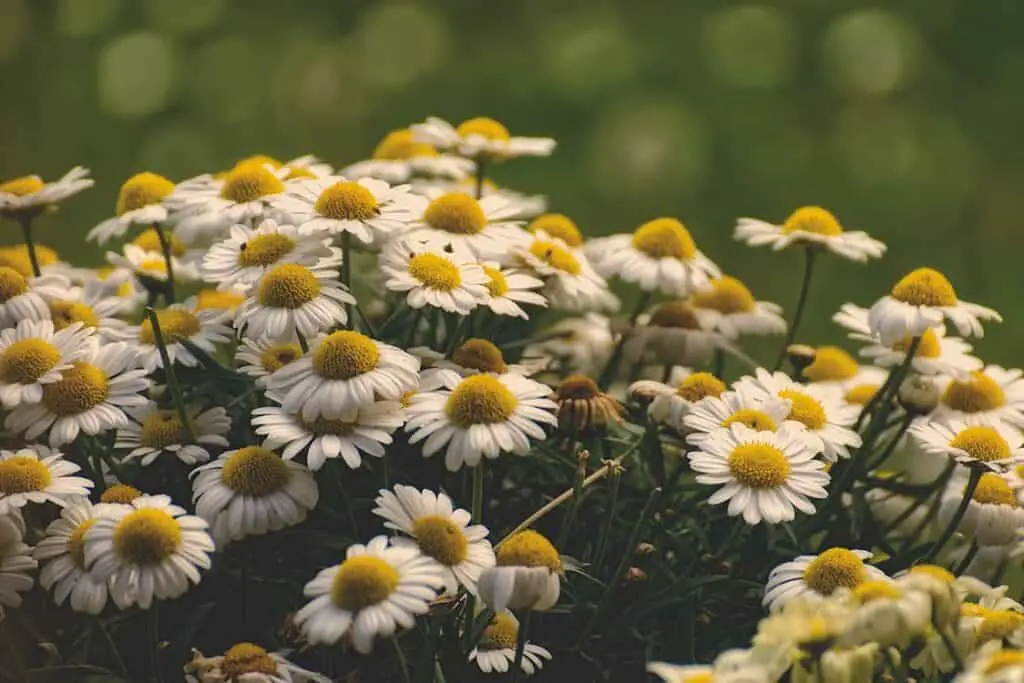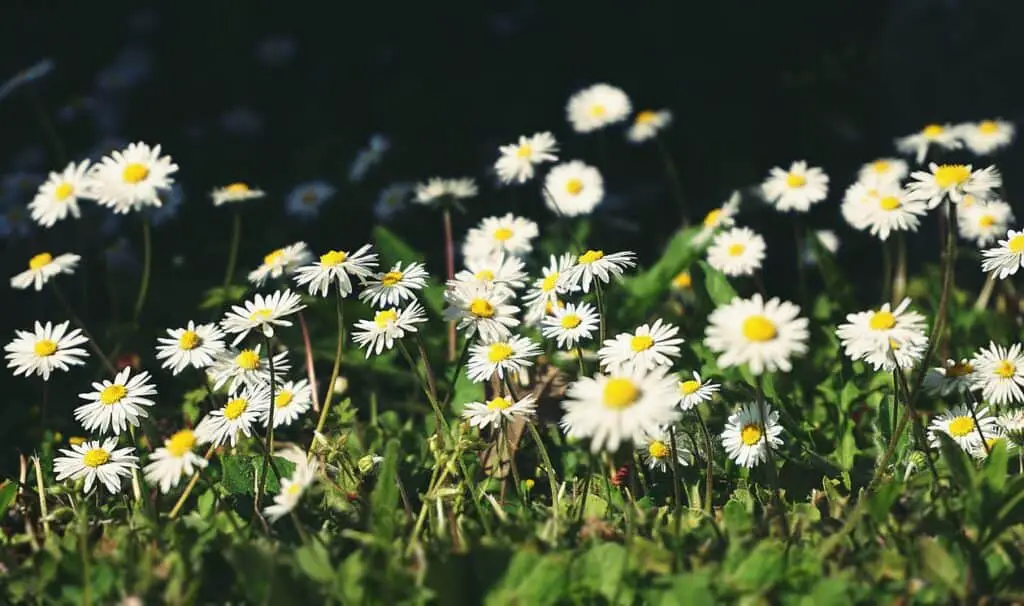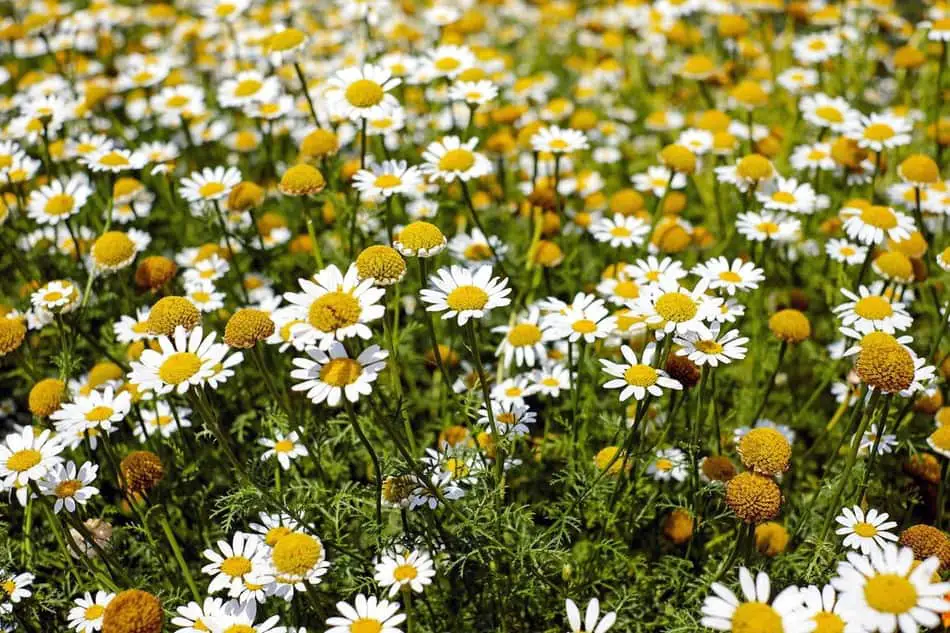Chamomile is one of the most popular, easy-to-grow plants for tea. It’s a must-have in my tea garden for me. It brightens up the garden and makes a delectable cup of tea to keep you toasty and comfortable. I’ll teach you how to dry chamomile and brew a tea and when and how to harvest it.
How to harvest chamomile for tea? Harvesting chamomile is a simple and pleasurable task. Gently pinch the plant’s stem just below the flower’s middle. To remove the flower’s head, press your finger against the top of the cap while squeezing your fingers together.
When Is the Best Time to Harvest Chamomile?
It’s a day of conflicting emotions when it’s time to gather chamomile blooms. The cheerful chamomile flowers begin their trip from the garden to become a cup of tea. Fortunately, the pain of loss is quickly replaced by the happiness of discovering new blossoms!
The best time to harvest chamomile is in the morning before the day’s heat sets in, much like other herbs. Because too much moisture might harm your crop, wait until the morning dew has evaporated, and there will be no rain before harvesting in a dry location.
It’s time to pick your chamomile flowers when your petals have finished opening and are flat or slightly slanted against the center of the flower. Flowers are at their most nutrient and oil-rich phase as the petals fall away from the flower’s heart.
The German chamomile Matricaria chamomilla may be harvested once a day or once every seven days, depending on the size of the plants. You may also pick flowers from the garden for a cup of fresh chamomile tea each day.
Use twice as many buds as dry chamomile flowers to avoid bitterness. Fresh chamomile has less potency than dried chamomile, so use twice as many buds. When you grow chamomile, you’ll be able to enjoy the plant’s flowers throughout the summer.
Chamomile blooms rapidly dry and self-seed, so pick as many before spreading. Tiny chamomile plant seeds are usually in the most unexpected locations as the wind blows them about.
Some people may find this appealing, but it can become invasive in the wrong natural setting. Keep an eye out for chamomile blooms before they dry up.
If you live in a zone that gets cold at or before the end of April, chamomile is an excellent plant for your garden. Depending on your growing area, you may be able to get several harvests from a single plant or patch of chamomile flowers. The ideal times to obtain multiple harvests from one plant are late summer and early fall.
Drying Chamomile

Remove any insects or debris from the flower heads using a gentle shake and visual inspection.
If desired, flowers may be washed in a basin of water. The blossoms should be completely drained and patted dry gently. I don’t always clean the blooms.
1. Air-Dry
Allow the flowers to dry for one to two weeks in a dark, warm, and dry environment.
2. Dehydrate
If the flower petals aren’t placed in a dehydrator tray lined with paper or plastic, they will fall through the mesh.
Cover the tray with a mesh liner to keep the flowers from blowing away while drying. Dry food for 12 to 18 hours at this temperature in a dehydrator.
Choosing the correct dehydration method is critical to obtaining high-quality results. Dehydrate delicate herbs and flowers at the lowest possible temperature to achieve optimum outcomes.
3. Storing Chamomile
Dried and cooled chamomile flowers may be kept in a well-sealed glass jar until harvest next year. Dried herbs should never be stored in direct sunlight or heat to retain their color, flavor, and healing properties.
Making Chamomile Tea
To prepare one cup of chamomile tea, combine eight ounces of boiling water with 1-2 tablespoons of dried chamomile flowers. Allow the infusion to steep for 5 minutes before straining and adding honey or other sweeteners.
However, each home gardener has a special recipe when it comes to chamomile tea. Echinacea and lavender are frequently used additives in beverages because of their taste and medical benefits.
In savory dishes, mint and chamomile are frequently used as cooling spices. The sky is the limit when it comes to innovation!
Benefits Of Chamomile
Chamomile tea is soothing and relaxing, ideal for stomach aches, anxiety, or sleeplessness. My mother used to make chamomile tea for us when we were unwell or couldn’t fall asleep. My children ask for a cup of chamomile whenever they’re feeling under the weather.
A cup of chamomile tea is a wonderful method to unwind and relax.
Chamomile’s cheerful, daisy-like flowers brighten up any environment with their beauty and practical functions. Gardeners who know how to harvest chamomile tea may enjoy it.
The teeny-tiny chamomile plant has a powerful, alluring scent that will entice anybody who passes by. It has a pleasant, almost fruity fragrance that humans enjoy but insect pests despise.
Chamomile is also medicine and food for millennia. Herbalists use this plant to cure several ailments, including inflammation, sleeplessness, rheumatic pain, and stomach upset. The essential oils in this plant may also help the body’s natural defenses.
Chamomile flowers are easy to cultivate and harvest, resulting in frequent use and popularity. The flowers may be able to produce chamomile salves, which heal small wounds or insect stings.
If you’re unsure what to do with them, set the seeds aside and leave any new flowers. Remove all of the flower heads that are in full bloom, however. For 1-2 weeks in a dark, warm, and dry area, paper towels or cheesecloth may be laid out in a single layer and allowed to dry.
You can dehydrate these items at the lowest setting. You can keep dried and cooled flowers in a sealed glass jar for six months. They’ll still function after six months, but the flavor will weaken.
Conclusion

The strong, enticing aroma of chamomile will attract anybody who passes by. These flowers are also herbal salves to treat minor injuries and bug bites.
How to harvest chamomile for tea? chamomile can be harvested easily and pleasurably. Simply pinch the plant’s stem just below the flower’s middle. To remove the head of a flower, tightly squeeze your fingers together while pressing your finger against the top of the cap.
You can harvest chamomile at any time, although the best time to take it is before the day’s heat begins. To avoid damaging your plants, harvest in a dry location. Depending on your plants’ size, harvests can be done daily or weekly.
Related Articles:

